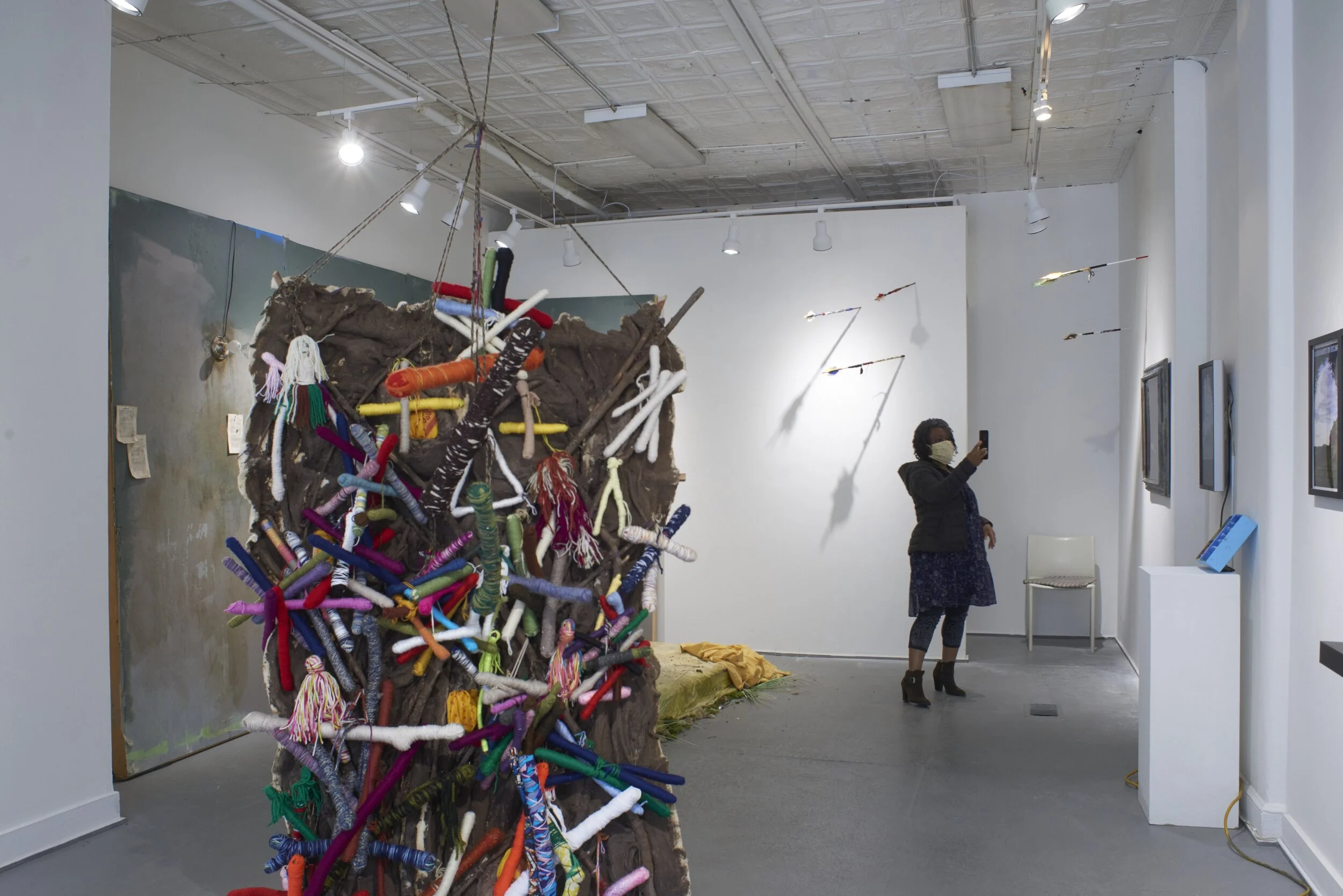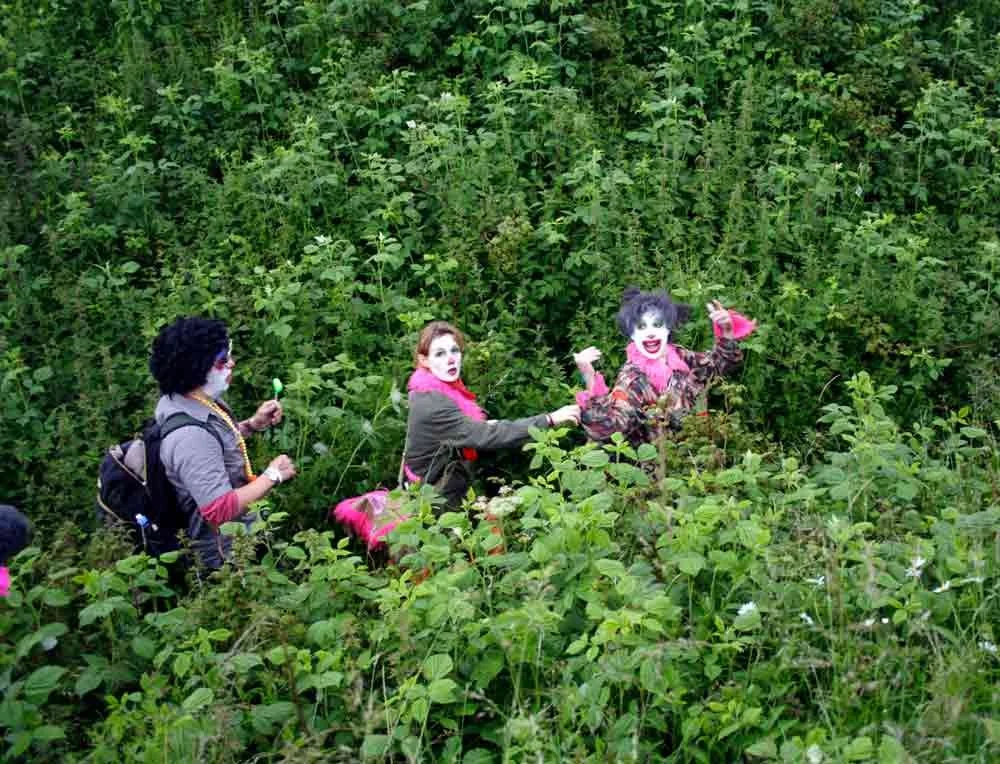Legacy and Rupture is an exhibition of seven artists, each reimaging how Black Americans are viewed and understood. This exhibition is curated by interdisciplinary artist and educator Howard el-Yasin. Legacy & Rupturebrings together work expressing the multiplicity of African American identities, framed by the everydayness of precarity, trauma, and memories at the City Gallery in New Haven, CT. The exhibition opens May 1st and ends May 30th of 2021.
Without Black legacy Black people can experience perceptions of fragility or incompleteness. In the void, we seek connection to our indigenous selves or reimage the world in our own image. We strive to assimilate with time and space. Legacy ruptures the narrative of loneliness — blackness does not have to be a vacuum; it can be an enveloping force. Blackness is not darkness — it is expansion.
Being Black means being part of the Black legacy. Being an empowering and unyielding force for the Black ethos rather than a disparate appendage of other people’s judgements of blackness. Having a legacy also means being entitled to space and having access to time. And not just having space but having a celebrated space. Not just existing in time but being seen within time — throughout it.
Time and space measure our reality. Space — three dimensions; four walls, or the world, as we interact with it. Time — the 4th dimension; a biform of the linear and the cyclical. Time, as we experience it, is linear but any historian will tell you that the events and the ideals are cyclical — chronic. Professor and author, Christina Sharpe, reminds us that “the past that is not past reappears, always, to rupture the present.”
Trauma reappears. Too often, the legacy of African American lives is trauma, work, and chronic pain. Those of us who descend from slaves carry the discomfort of displacement with us. Those who emigrant voluntarily carry the fear of the families they left behind. When we do not heal from the wounds of our history the scars will fester and erupt. This creates a dimensionality to trauma that allows it to cause intergenerational suffering — a legacy of trauma.
This exhibition creates a liminal oasis between space and time as a method of healing. Within art we can be seen — finally seen — as our true selves and that is a catalyst for congruence. For African Americans, congruence is especially challenging — allowing one’s view of themselves to no longer conflict with one’s view of Blackness — not only being accepted into the Black community but accepting ourselves as part of the Black community and as an individualized representation of Blackness.
In this exhibition, the artists self-identify within history — within time and space. This art is a refraction of the artists’ identities, allowing the audience to explore differences in representation rather than a reproduction of blackness.
THE ARTISTS & THE ART
Indigenous Trauma, arrows 24” length x 3/8” diameter, sculpture installation with variable dimensions; mixed media: feathers, wood, paint, metals, brass beads, leather, plastic, twine, bone, human hair, stone
Indigenous Trauma corporealizes the intersection of the African Americas experience and the Indigenous North American experience. These two ethnicities have parallel histories of displacement and disenfranchisement, and those histories intersect significantly when the first slaves were brought to the Americas. Artist Ari Montford plays with this intersection by manipulating arrows (a stereotypical and articulate Indigenous symbol).
Each arrow is a story. A story untold about Indigenous history. A story of intergenerational violence and trauma. A story of joy and hope and love. Uniquely decorated but not decoration. More of a demonstration — of histories intertwined. Thinking of African Americans as an indigenous culture is a fairly modern phenomenon. But just like many indigenous communities worldwide, African Americans have been displaced; almost misplaced.
Each arrow relies on the cultural assumptions and the traditional realities of its form. The arrows interrogate histories of genocide and biological warfare throughout, now dismembered, aboriginal American communities, while also celebrating the immersive cultural practices essential to creating such unique works of folk art. They are monuments to undocumented battles, as well as aesthetic expressions of heritage and cultural reverence. Montford’s piece propels the narrative of indigenous art forward. Each arrow explores the multiplicity experiences within the Indigenous American diaspora.
Individually wrapped, intuitively ornamented, and precisely placed –the fabrication of each arrow reflects a ritual practice. The African spiritual observances that utilize North American indigenous species and materials are part of the Hoodoo practice. Most magical practice in African communities have been suppressed by Christian doctrines and negative cultural iconographies. Magic accesses spiritual inheritance by using combinations of physical materials and focused intention to pierce through to the metaphysical plane. The resources used to create Montford’s arrows are ingredients in a spell that allow the artist to transverse a void of understanding, unencumbered by expectation, and rupture the implied entitlement and authority of a white gallery space.
Trickster, skeleton frame: 77 x 60 inches, sculpture installation with variable dimensions; mixed media: wool blanket, sari, wooden sticks, fabric, yarn, ground coffee and acrylic gel
Sika Foyer works with magical and spiritual figures. Through ornamentation and adornments, Trickster celebrates Indigenous African culture and theology. Each stick was attentively and tirelessly wrapped and can be moved independently. They are the building blocks for a living entity. The sticks and yarn and fabric imitate colorfully decorated nucleotides building the adaptive and resilient DNA of an African Trickster god — a chameleon and an enigma. Foyer’s piece negotiates space like a God, being expansive and unashamed. The “collective engagement” of the independently working parts echo the seamless mechanisms of a hive mind.
The trickster reminds us of who we truly are. He mirrors or flaws and exploits our fears, deepening our understanding of our own motivations and conflicts — “what is hidden in plain sight”. His has a legacy of resilience, always escaping to safety at the last minute.
Foyer was born and raised in Lomé, Togo, West Africa and the shapes and colors in this piece link her work to the contours and embellishments of Sub-Saharan African masks. When Foyer was young, she worked beside her mother (a designer and a dressmaker) and experimented with design and construction. The fragments from the Trickster are reminiscent of string and scraps left behind from a dress’ completion, or perhaps they are the starting fabric and thread for a quilt that is yet unrealized.
For this artist, the process is a bullet — a finite thought — that ruptures through the subconscious into your lived experience. And the art is just the shrapnel, the debris. The scattered pieces that are reassembled into music and rhythm.
In a subtle but noticeable change, the pattern is transposed a step- higher; variable, mixed media
Nathanial Donnett works with mundane, overlooked objects such as paper, graphite, books, string to visualized abstract patterns. Each image, at first glance, is a collage of shadow, line & texture but every slight marking requires investigation.
Framed pieces depict meandering maps and mazes without legends or borders. Shadows and hesitation marks overlap to build form. Loose and taut strings connect invisible loci, mapping an expedition through an indistinct ecosystem. But the ecosystem is actually very specific — it is black and white; it is light and dark. Collaged advertisements look up from a sunken abyss and deliberate lines cut across a scattered galaxy. The layers upon layers of material emphasizes the complexity of each experience.
The framed pieces set the tone, but the unframed objects relay the rhythm. Chimes, made from shoelaces and metal eyelets and a hand fan embossed with an image of a dingy brick wall littered with garbage, evoke a singular urban poeisis. The vinyl sleeve for Ornette Coleman’s The Art of the Improvisers and Morgan Natalie Crawford’s book Black Post-Blackness are affixed upside down as a poignant statement against even progressive notions of African American individuality and social mobility. Donnett says about his work, “the install in the gallery is… about extracting meaning in a material from the video piece and trying to create music out of the works as a whole and individually.”
The work documents the unseen parts of universe, the ephemeral things that encircle us but remain out of reach to the physical plane. Dark matter is the invisible substance that makes up 85% of matter in the universe and causes gravitational distortions. Dark matter is looked through — not at — and it interacts with everything on a subatomic level. A reflection of dark matter, the forms and gestures within Donnett’s work, are never in focus but always in frame. They transform texture and dimensionality while exploring a notion of incompleteness. Overgrown trails. Faded images. Loose strings connecting abstract interpretations. The images engage the audience to deduce for themselves — to project into the void.
Veil, 73” x 60’; oil and acrylic on canvas
Veil uncovers myths about toxic masculinity. Kamar Thomas studies male performance in public vs private spaces and collides with cultural expectations in his paintings. Historically, Black people are not the subject of portraits, they are props in the background — badges of wealth and decadence. Thomas features Black faces prominently and majestically to bring attention to the humanity of Black men.
The artist layers images of his own painted and masked face with digital flower trimmings. Thomas reverts the expectation of Black people interacting with nature and beauty. As the pandemic hit and people were forced into their homes and forced to cover their faces. Each one of us experienced the sting of being a faceless part of the crowd; being a statistic. We all got to experience a moment in the life of an anonymous Black man. This portrait reminds us of a Black man’s beauty and of his worth. A real man is safe, he is illuminated, he is flourishing.
The legacy of Black portraits is no longer a faded colorless photograph; Black portraits are full of life and freedom and color. Black beauty ruptures the narrative of black insecurity. Black love ruptures the narrative of Black danger. And Black glamour now is a form of Black armor.
Coming Out, 36 x48"; acrylic and collage
Ransome initiates a conversation about identity and sexuality in Coming Out. The subject of intimacy between African American males is controversial and clandestine. Even between fathers and sons, physical expressions of closeness are only recently becoming expected and celebrated. Within heterosexual male communities expressing physical affection is categorized as feminine or childish. Intimacy between men is a powerful rupture of expectation. Love between Black men, as depicted by acrylic paint and paper collage, forges a path towards acceptance and introspection.
For most young, LGBTQ+ individuals coming out is still a major milestone, and it can be an empowering experience or a devastating one. Headlines about recent legislation limiting health care for trans youth contradicts the hope granted by 2015’s historic Supreme Court decision legalizing gay marriage. Still, exhaustive accounts of anti-gay violence ripple through queer communities. Coming Out exposes the insecurities tied to being seen publicly as one’s true self.
The silhouetted figures are suspended in a forbidden lip lock, physically separated but energetically entwined. Their skin is in shadow — bathed in cold blue — the picture of stoic masculinity. The figures are enrobed in pink and purple and floral patterns to irradiate their societal duplicity. The quilt that conceals their bodies is decorated with a pattern adjacent to the “wedding ring” pattern stitched into quilts as a nuptial gift. The passionate lovers are suspended in time, unable to consummate their secret affections. The couple is almost hidden in plain sight — holding space for their love while subverting their fervent actions.
Untitled, 12’ x 4’ installation
Your absence is my monument, untitled 5; archival ink jet print
Merik Goma has created a stage and has sets the stage with scattered relics to create modern ruins — holding space and suspending time within its walls. These are the ruins of a society misremembered. Repeatedly the African American experience is depicted as loud, aggressive, and action oriented — urban. This installation celebrates the silence, the void, the aftermath. This scene is the quiet after the storm. A mutilated field after a tornado. The absence is essential to its mysticism and its realism.
Magic manifests in this installation through the growth, the undergrowth. Although the room is suspended in time — suspended in memory — the world around it lives on. Growing life betrays the illusion of timelessness. Grass and moss bloom beneath the mattress and spread forever outward to consume these theatrical remnants. I am reminded of the poem Ozymandias by Percy Shelley in which, after decades, sand has overcome the epic monument of the great pharaoh. His heroic shrine is covered, his thunderous words have worn away, and “Nothing besides remains”.
This set is like a recently extinguished candle; smoke still billows forth long after the flame is gone. That moment is suspended — or perhaps slowed — so the audience can absorb the gravity of the event. Even Goma admits to not having the full story, stating plainly, “I can only share a fraction of it”. The only fragment of forensic evidence is the picture placed opposite of the stage that depicts a man, looming over the empty bed, pondering the absence, possibly recollecting the consequences. He is illuminated slightly by the sunset oozing through the feebly boarded windows. His quiet contemplation suggests regret or loss upon revisiting the solemn still life.
Monuments to Escape, approximately 13’ multi-media wall installation
Marissa Williamson’s Monument’s to Escape is an immense art experience. The panels guide the audience through histories untold. The guide maps the stories of whispered histories — warm on your ear and gone with the wind. Each wall panel includes a question or statement designed to scrutinize the viewer’s historic dissonance. The panels are each a snapshot of legacies we refuse to face.
Some panels represent a remembering of the aboriginal American’s intimacy with the land. Another panel compares the stereotypical “Native American” connection to maize with modern America’s mass production and inordinate profit from corn as a source of animal feed and corn syrup. The artist reimagines the slave narrative of incompleteness and loneliness with questions like, “What is your North Star?’ Each panel is fighting against capitalistic, neocolonial memorials with quiet headstones of African American legacy.
There are cosmic energies framing historic figures and symbols and they reflect our energetic inheritance. The Earth and the galaxy also retain scars — physical trauma — and fears — cosmic trauma. The land exposed the histories we cut into it. The chasms of displacement are felt by the planet. The land longs for its biological companions; the plants and animals and life it has birthed and nurtured. Will we leave a legacy of compassion and mutualism or a legacy of parasitic exploitation?
In monuments, the past meets the present. Lives are relived when their stories are told. The artist leaves a time capsule of hope next to her installation in the form of pencils and scraps of paper. A glimmer of the stories of the future — holding space for present impulses. Time is not just the past but the future and the present. Art captures the piece of the soul and displays it as an imperishable timepiece — proof of transformation.
Black legacy disrupts; and rupture will be our legacy. It is essential to continue to bring together expressive and distinctive artistic voices that bridge the cultural crevasse between Black history and Black understanding.
Like the moon through the night sky, time returns in phases. Phases of oppression, anger, revolution, and healing. Legacy & Rupture creates space — an ephemeral passageway — between these phases and promotes healing and cosmic recognition. This exhibition of art ruptures and disrupts the expectations of blackness, the conversations around blackness, and the inheritance of blackness and replaces legend with striking legacy.
Images provided by curator Howard el-Yasin, photo credit to artist, Merik Goma.




























































